Gender Inequality in the Construction Industry: An India Case Study
VerifiedAdded on 2023/05/31
|21
|3667
|108
Case Study
AI Summary
This case study investigates gender inequality within the Indian construction industry, focusing on wage disparities, motivation, and overall empowerment of women. The study employs descriptive and inferential statistical methods, including correlation and regression analyses, to analyze data related to wages, job satisfaction, and perceptions of discrimination. Results indicate that women in the Indian construction industry perceive significant wage discrimination and a lack of motivation compared to their male counterparts. The study identifies challenges such as societal mindsets, risks associated with the job, and maternity leave, which contribute to gender inequality. The research concludes with recommendations for promoting gender parity and improving the welfare of women employees in the Indian construction sector.
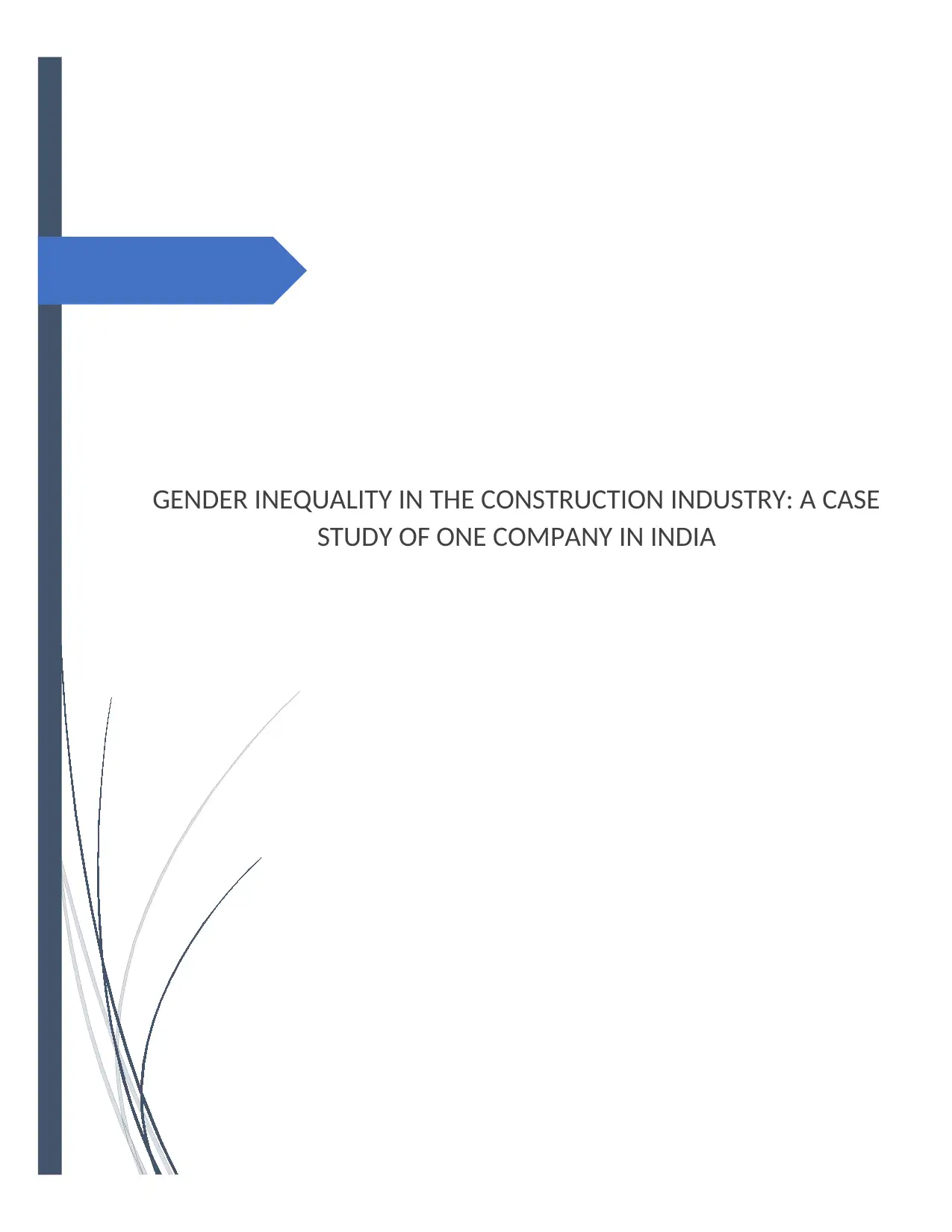
GENDER INEQUALITY IN THE CONSTRUCTION INDUSTRY: A CASE
STUDY OF ONE COMPANY IN INDIA
STUDY OF ONE COMPANY IN INDIA
Paraphrase This Document
Need a fresh take? Get an instant paraphrase of this document with our AI Paraphraser
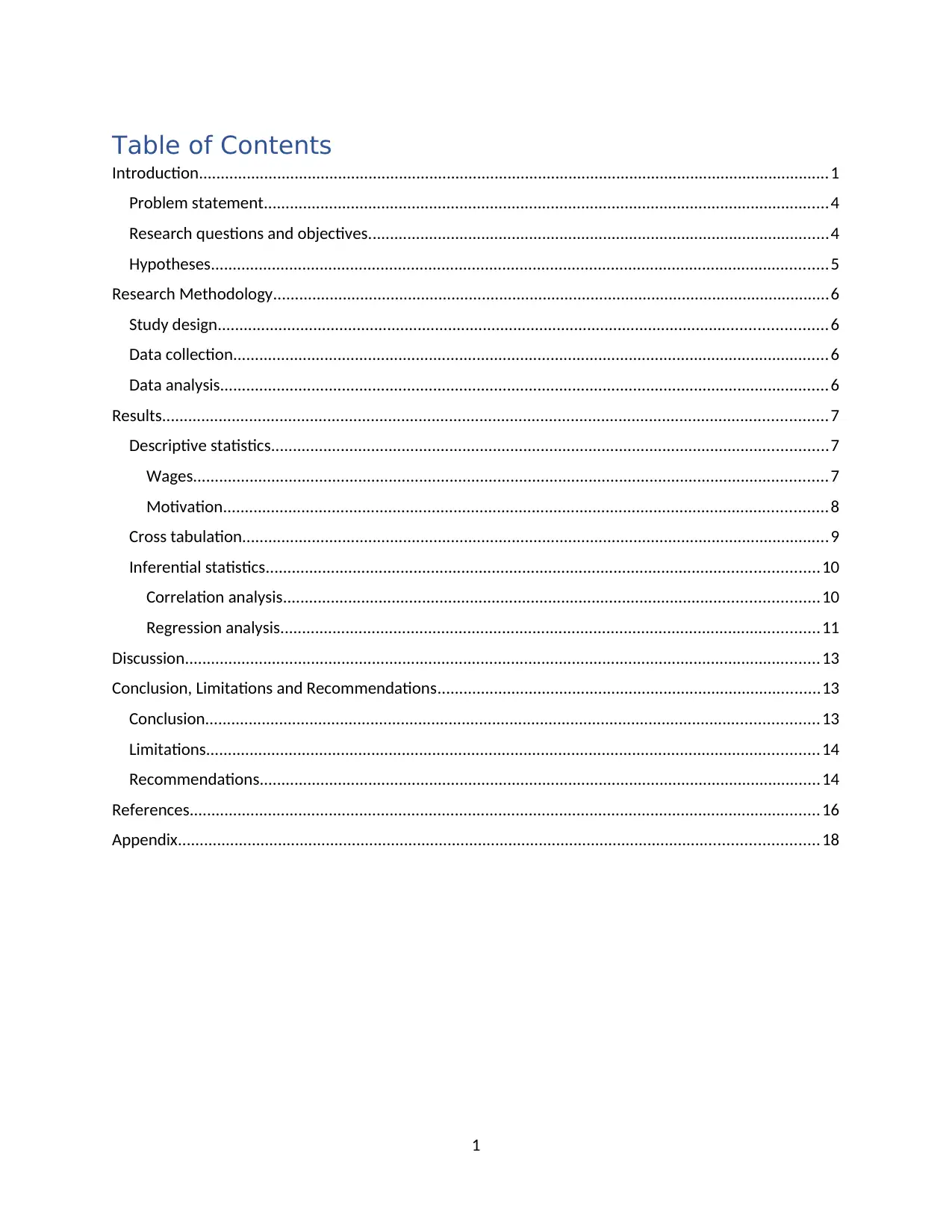
Table of Contents
Introduction.................................................................................................................................................1
Problem statement..................................................................................................................................4
Research questions and objectives..........................................................................................................4
Hypotheses..............................................................................................................................................5
Research Methodology................................................................................................................................6
Study design............................................................................................................................................6
Data collection.........................................................................................................................................6
Data analysis............................................................................................................................................6
Results.........................................................................................................................................................7
Descriptive statistics................................................................................................................................7
Wages..................................................................................................................................................7
Motivation...........................................................................................................................................8
Cross tabulation.......................................................................................................................................9
Inferential statistics...............................................................................................................................10
Correlation analysis...........................................................................................................................10
Regression analysis............................................................................................................................11
Discussion..................................................................................................................................................13
Conclusion, Limitations and Recommendations........................................................................................13
Conclusion.............................................................................................................................................13
Limitations.............................................................................................................................................14
Recommendations.................................................................................................................................14
References.................................................................................................................................................16
Appendix...................................................................................................................................................18
1
Introduction.................................................................................................................................................1
Problem statement..................................................................................................................................4
Research questions and objectives..........................................................................................................4
Hypotheses..............................................................................................................................................5
Research Methodology................................................................................................................................6
Study design............................................................................................................................................6
Data collection.........................................................................................................................................6
Data analysis............................................................................................................................................6
Results.........................................................................................................................................................7
Descriptive statistics................................................................................................................................7
Wages..................................................................................................................................................7
Motivation...........................................................................................................................................8
Cross tabulation.......................................................................................................................................9
Inferential statistics...............................................................................................................................10
Correlation analysis...........................................................................................................................10
Regression analysis............................................................................................................................11
Discussion..................................................................................................................................................13
Conclusion, Limitations and Recommendations........................................................................................13
Conclusion.............................................................................................................................................13
Limitations.............................................................................................................................................14
Recommendations.................................................................................................................................14
References.................................................................................................................................................16
Appendix...................................................................................................................................................18
1
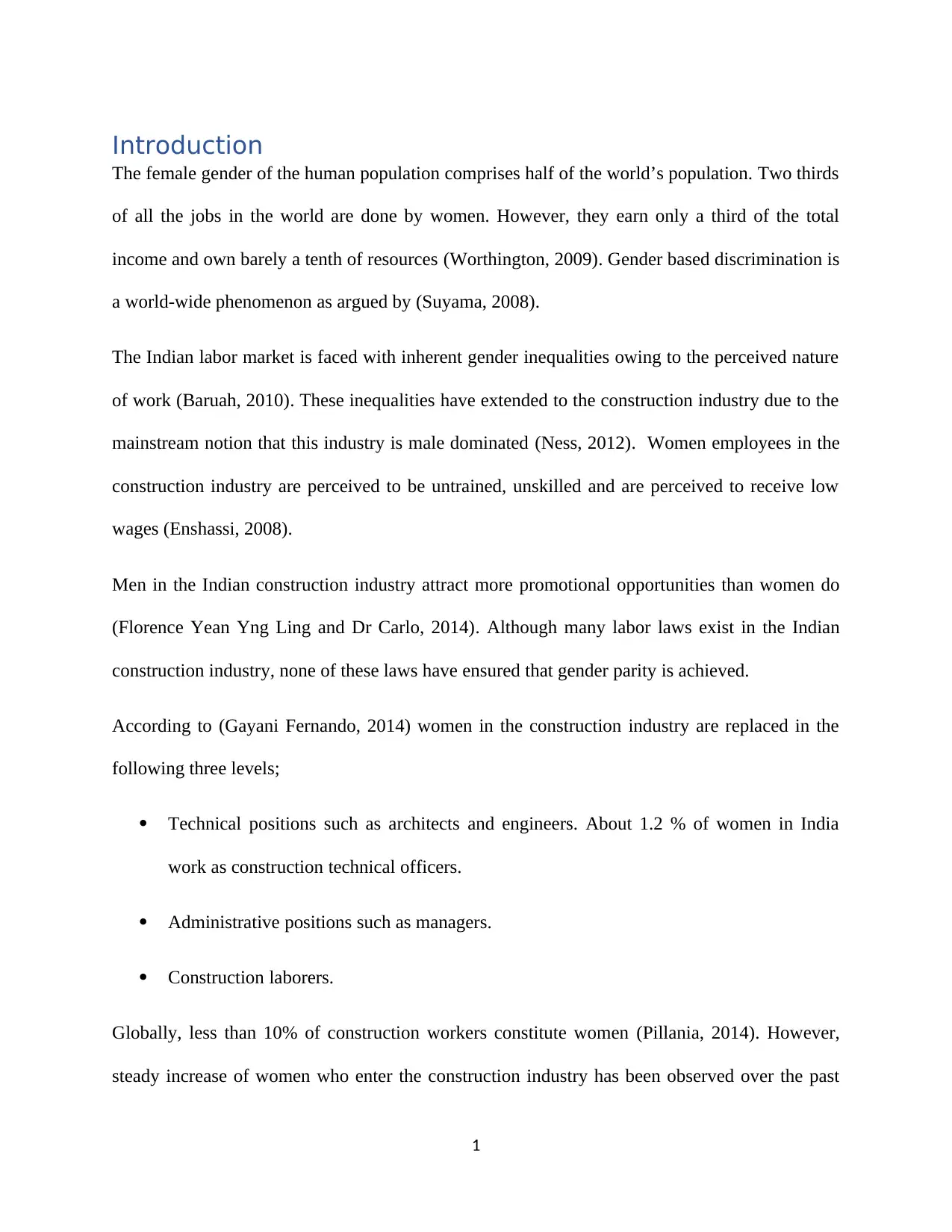
Introduction
The female gender of the human population comprises half of the world’s population. Two thirds
of all the jobs in the world are done by women. However, they earn only a third of the total
income and own barely a tenth of resources (Worthington, 2009). Gender based discrimination is
a world-wide phenomenon as argued by (Suyama, 2008).
The Indian labor market is faced with inherent gender inequalities owing to the perceived nature
of work (Baruah, 2010). These inequalities have extended to the construction industry due to the
mainstream notion that this industry is male dominated (Ness, 2012). Women employees in the
construction industry are perceived to be untrained, unskilled and are perceived to receive low
wages (Enshassi, 2008).
Men in the Indian construction industry attract more promotional opportunities than women do
(Florence Yean Yng Ling and Dr Carlo, 2014). Although many labor laws exist in the Indian
construction industry, none of these laws have ensured that gender parity is achieved.
According to (Gayani Fernando, 2014) women in the construction industry are replaced in the
following three levels;
Technical positions such as architects and engineers. About 1.2 % of women in India
work as construction technical officers.
Administrative positions such as managers.
Construction laborers.
Globally, less than 10% of construction workers constitute women (Pillania, 2014). However,
steady increase of women who enter the construction industry has been observed over the past
1
The female gender of the human population comprises half of the world’s population. Two thirds
of all the jobs in the world are done by women. However, they earn only a third of the total
income and own barely a tenth of resources (Worthington, 2009). Gender based discrimination is
a world-wide phenomenon as argued by (Suyama, 2008).
The Indian labor market is faced with inherent gender inequalities owing to the perceived nature
of work (Baruah, 2010). These inequalities have extended to the construction industry due to the
mainstream notion that this industry is male dominated (Ness, 2012). Women employees in the
construction industry are perceived to be untrained, unskilled and are perceived to receive low
wages (Enshassi, 2008).
Men in the Indian construction industry attract more promotional opportunities than women do
(Florence Yean Yng Ling and Dr Carlo, 2014). Although many labor laws exist in the Indian
construction industry, none of these laws have ensured that gender parity is achieved.
According to (Gayani Fernando, 2014) women in the construction industry are replaced in the
following three levels;
Technical positions such as architects and engineers. About 1.2 % of women in India
work as construction technical officers.
Administrative positions such as managers.
Construction laborers.
Globally, less than 10% of construction workers constitute women (Pillania, 2014). However,
steady increase of women who enter the construction industry has been observed over the past
1
⊘ This is a preview!⊘
Do you want full access?
Subscribe today to unlock all pages.

Trusted by 1+ million students worldwide
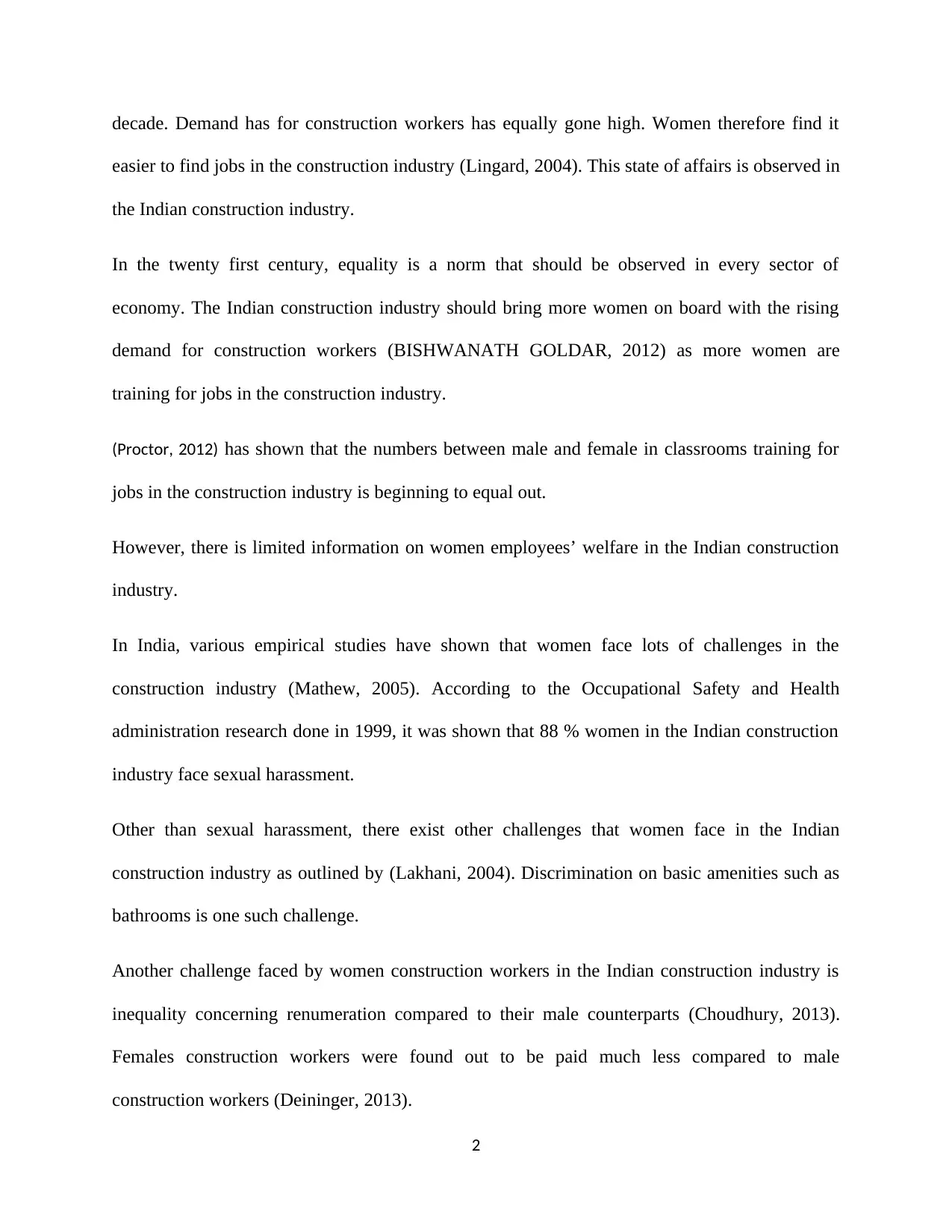
decade. Demand has for construction workers has equally gone high. Women therefore find it
easier to find jobs in the construction industry (Lingard, 2004). This state of affairs is observed in
the Indian construction industry.
In the twenty first century, equality is a norm that should be observed in every sector of
economy. The Indian construction industry should bring more women on board with the rising
demand for construction workers (BISHWANATH GOLDAR, 2012) as more women are
training for jobs in the construction industry.
(Proctor, 2012) has shown that the numbers between male and female in classrooms training for
jobs in the construction industry is beginning to equal out.
However, there is limited information on women employees’ welfare in the Indian construction
industry.
In India, various empirical studies have shown that women face lots of challenges in the
construction industry (Mathew, 2005). According to the Occupational Safety and Health
administration research done in 1999, it was shown that 88 % women in the Indian construction
industry face sexual harassment.
Other than sexual harassment, there exist other challenges that women face in the Indian
construction industry as outlined by (Lakhani, 2004). Discrimination on basic amenities such as
bathrooms is one such challenge.
Another challenge faced by women construction workers in the Indian construction industry is
inequality concerning renumeration compared to their male counterparts (Choudhury, 2013).
Females construction workers were found out to be paid much less compared to male
construction workers (Deininger, 2013).
2
easier to find jobs in the construction industry (Lingard, 2004). This state of affairs is observed in
the Indian construction industry.
In the twenty first century, equality is a norm that should be observed in every sector of
economy. The Indian construction industry should bring more women on board with the rising
demand for construction workers (BISHWANATH GOLDAR, 2012) as more women are
training for jobs in the construction industry.
(Proctor, 2012) has shown that the numbers between male and female in classrooms training for
jobs in the construction industry is beginning to equal out.
However, there is limited information on women employees’ welfare in the Indian construction
industry.
In India, various empirical studies have shown that women face lots of challenges in the
construction industry (Mathew, 2005). According to the Occupational Safety and Health
administration research done in 1999, it was shown that 88 % women in the Indian construction
industry face sexual harassment.
Other than sexual harassment, there exist other challenges that women face in the Indian
construction industry as outlined by (Lakhani, 2004). Discrimination on basic amenities such as
bathrooms is one such challenge.
Another challenge faced by women construction workers in the Indian construction industry is
inequality concerning renumeration compared to their male counterparts (Choudhury, 2013).
Females construction workers were found out to be paid much less compared to male
construction workers (Deininger, 2013).
2
Paraphrase This Document
Need a fresh take? Get an instant paraphrase of this document with our AI Paraphraser
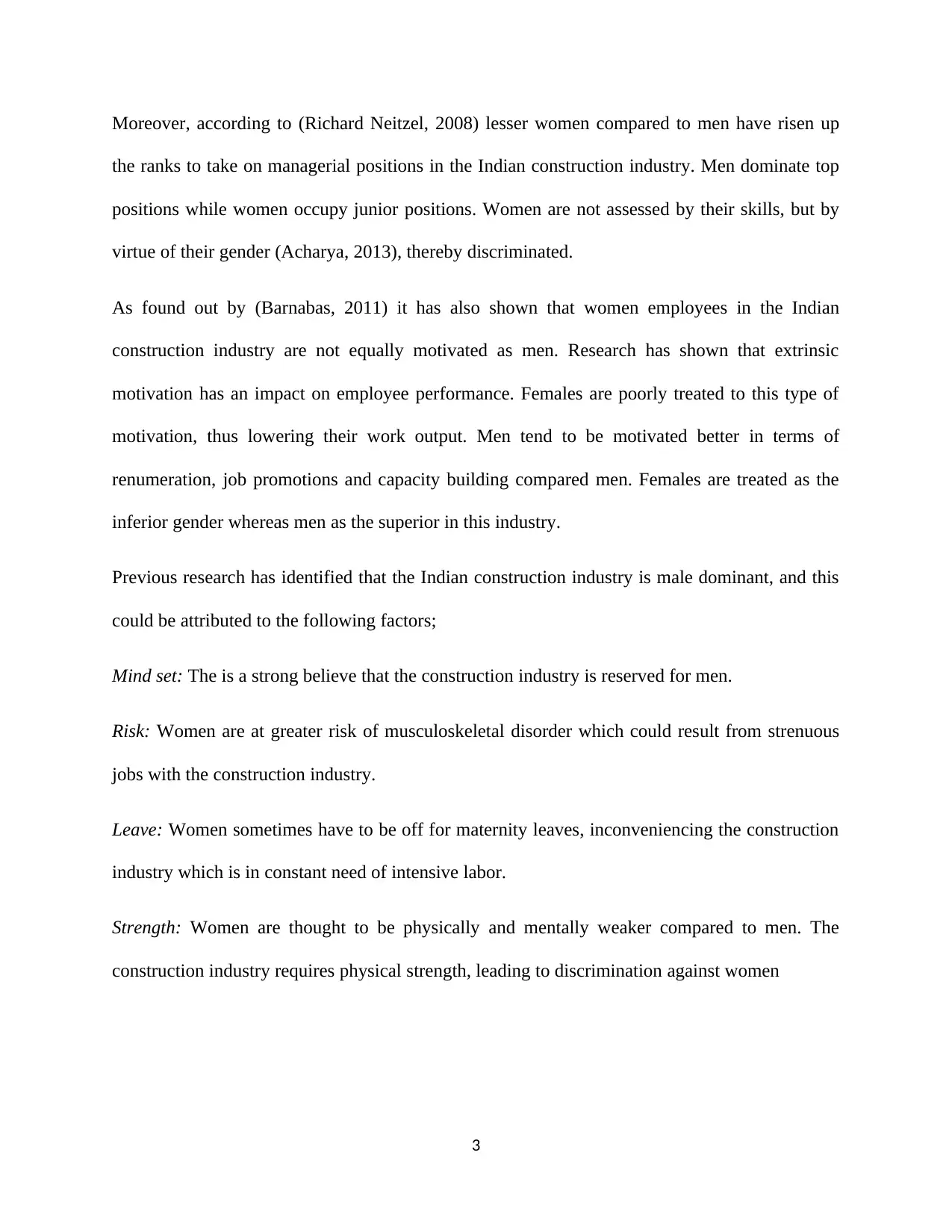
Moreover, according to (Richard Neitzel, 2008) lesser women compared to men have risen up
the ranks to take on managerial positions in the Indian construction industry. Men dominate top
positions while women occupy junior positions. Women are not assessed by their skills, but by
virtue of their gender (Acharya, 2013), thereby discriminated.
As found out by (Barnabas, 2011) it has also shown that women employees in the Indian
construction industry are not equally motivated as men. Research has shown that extrinsic
motivation has an impact on employee performance. Females are poorly treated to this type of
motivation, thus lowering their work output. Men tend to be motivated better in terms of
renumeration, job promotions and capacity building compared men. Females are treated as the
inferior gender whereas men as the superior in this industry.
Previous research has identified that the Indian construction industry is male dominant, and this
could be attributed to the following factors;
Mind set: The is a strong believe that the construction industry is reserved for men.
Risk: Women are at greater risk of musculoskeletal disorder which could result from strenuous
jobs with the construction industry.
Leave: Women sometimes have to be off for maternity leaves, inconveniencing the construction
industry which is in constant need of intensive labor.
Strength: Women are thought to be physically and mentally weaker compared to men. The
construction industry requires physical strength, leading to discrimination against women
3
the ranks to take on managerial positions in the Indian construction industry. Men dominate top
positions while women occupy junior positions. Women are not assessed by their skills, but by
virtue of their gender (Acharya, 2013), thereby discriminated.
As found out by (Barnabas, 2011) it has also shown that women employees in the Indian
construction industry are not equally motivated as men. Research has shown that extrinsic
motivation has an impact on employee performance. Females are poorly treated to this type of
motivation, thus lowering their work output. Men tend to be motivated better in terms of
renumeration, job promotions and capacity building compared men. Females are treated as the
inferior gender whereas men as the superior in this industry.
Previous research has identified that the Indian construction industry is male dominant, and this
could be attributed to the following factors;
Mind set: The is a strong believe that the construction industry is reserved for men.
Risk: Women are at greater risk of musculoskeletal disorder which could result from strenuous
jobs with the construction industry.
Leave: Women sometimes have to be off for maternity leaves, inconveniencing the construction
industry which is in constant need of intensive labor.
Strength: Women are thought to be physically and mentally weaker compared to men. The
construction industry requires physical strength, leading to discrimination against women
3
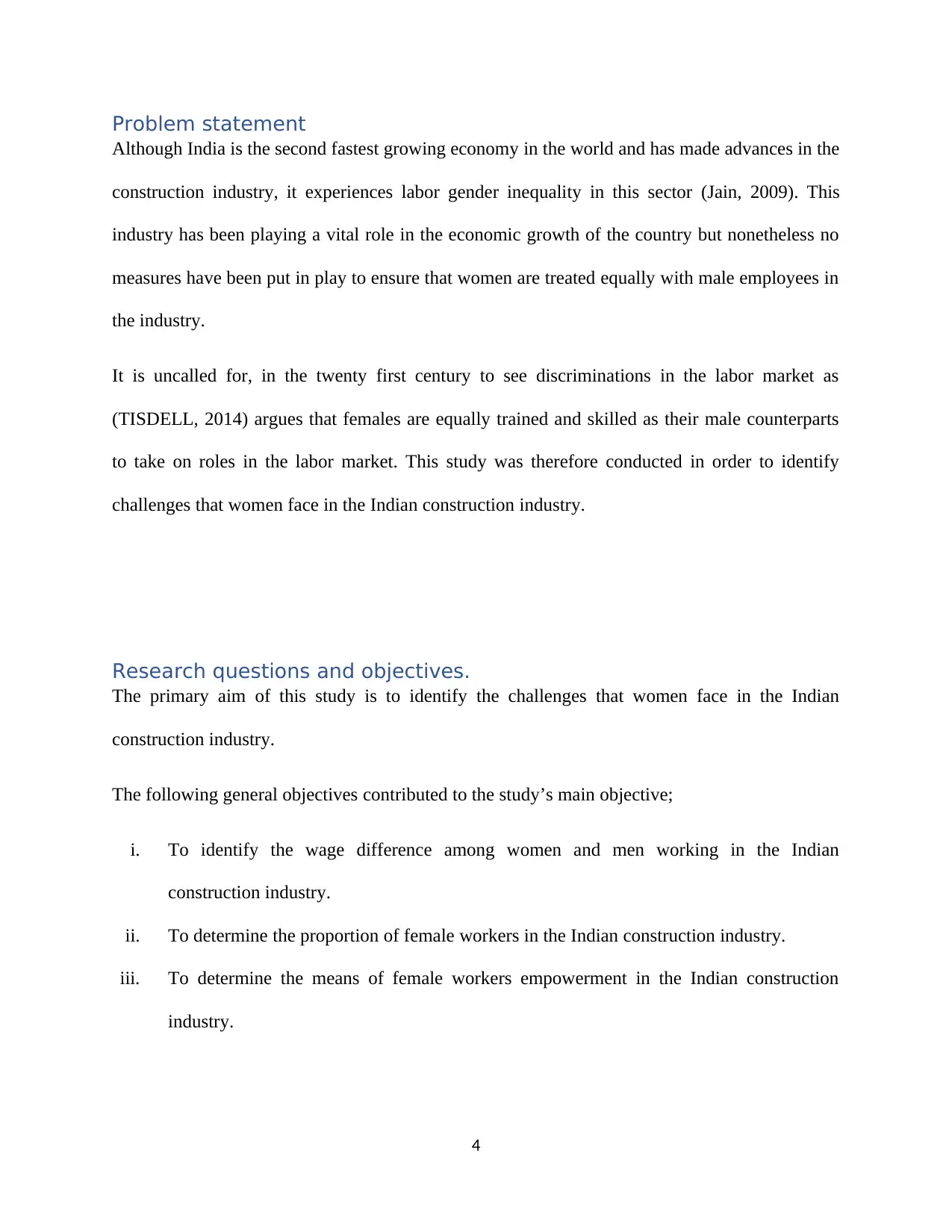
Problem statement
Although India is the second fastest growing economy in the world and has made advances in the
construction industry, it experiences labor gender inequality in this sector (Jain, 2009). This
industry has been playing a vital role in the economic growth of the country but nonetheless no
measures have been put in play to ensure that women are treated equally with male employees in
the industry.
It is uncalled for, in the twenty first century to see discriminations in the labor market as
(TISDELL, 2014) argues that females are equally trained and skilled as their male counterparts
to take on roles in the labor market. This study was therefore conducted in order to identify
challenges that women face in the Indian construction industry.
Research questions and objectives.
The primary aim of this study is to identify the challenges that women face in the Indian
construction industry.
The following general objectives contributed to the study’s main objective;
i. To identify the wage difference among women and men working in the Indian
construction industry.
ii. To determine the proportion of female workers in the Indian construction industry.
iii. To determine the means of female workers empowerment in the Indian construction
industry.
4
Although India is the second fastest growing economy in the world and has made advances in the
construction industry, it experiences labor gender inequality in this sector (Jain, 2009). This
industry has been playing a vital role in the economic growth of the country but nonetheless no
measures have been put in play to ensure that women are treated equally with male employees in
the industry.
It is uncalled for, in the twenty first century to see discriminations in the labor market as
(TISDELL, 2014) argues that females are equally trained and skilled as their male counterparts
to take on roles in the labor market. This study was therefore conducted in order to identify
challenges that women face in the Indian construction industry.
Research questions and objectives.
The primary aim of this study is to identify the challenges that women face in the Indian
construction industry.
The following general objectives contributed to the study’s main objective;
i. To identify the wage difference among women and men working in the Indian
construction industry.
ii. To determine the proportion of female workers in the Indian construction industry.
iii. To determine the means of female workers empowerment in the Indian construction
industry.
4
⊘ This is a preview!⊘
Do you want full access?
Subscribe today to unlock all pages.

Trusted by 1+ million students worldwide
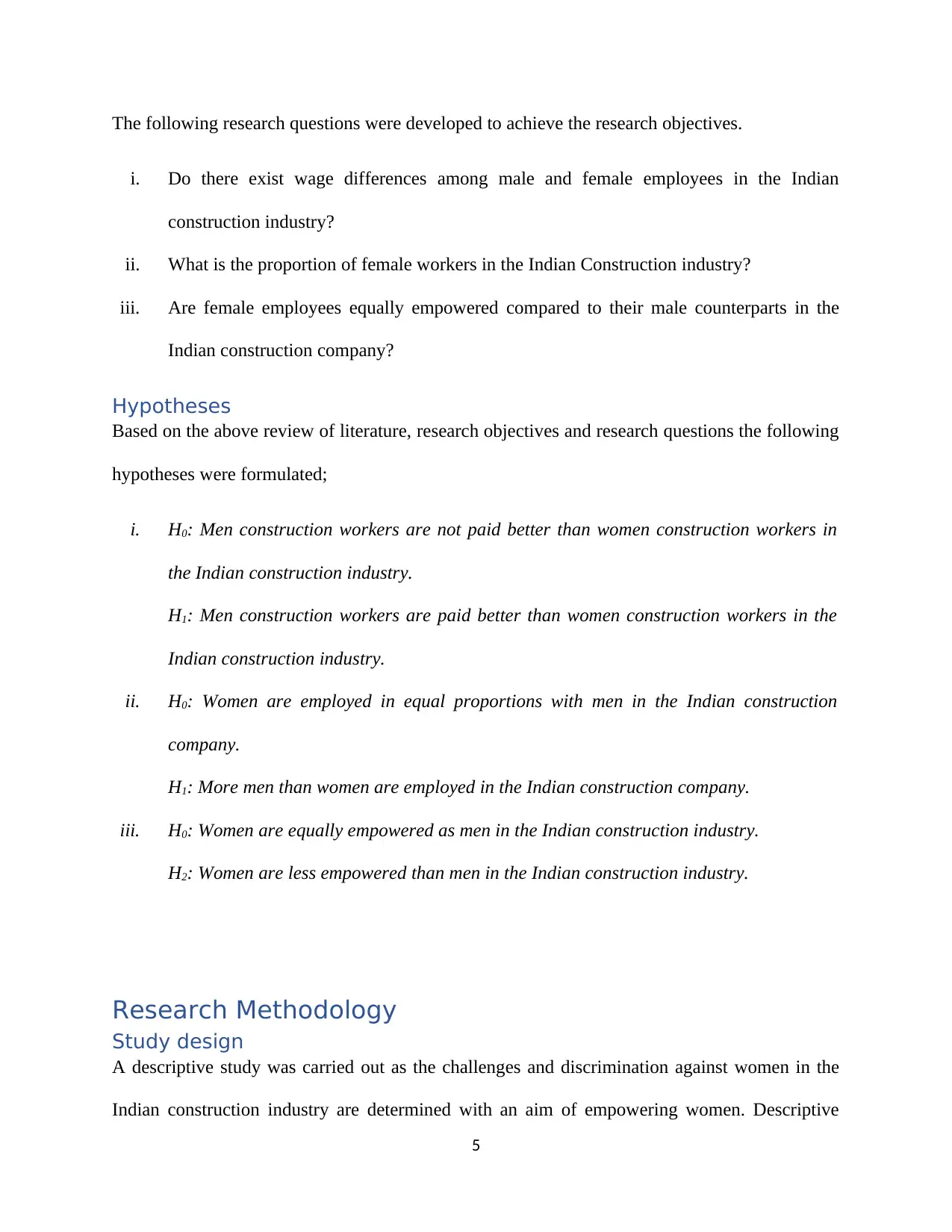
The following research questions were developed to achieve the research objectives.
i. Do there exist wage differences among male and female employees in the Indian
construction industry?
ii. What is the proportion of female workers in the Indian Construction industry?
iii. Are female employees equally empowered compared to their male counterparts in the
Indian construction company?
Hypotheses
Based on the above review of literature, research objectives and research questions the following
hypotheses were formulated;
i. H0: Men construction workers are not paid better than women construction workers in
the Indian construction industry.
H1: Men construction workers are paid better than women construction workers in the
Indian construction industry.
ii. H0: Women are employed in equal proportions with men in the Indian construction
company.
H1: More men than women are employed in the Indian construction company.
iii. H0: Women are equally empowered as men in the Indian construction industry.
H2: Women are less empowered than men in the Indian construction industry.
Research Methodology
Study design
A descriptive study was carried out as the challenges and discrimination against women in the
Indian construction industry are determined with an aim of empowering women. Descriptive
5
i. Do there exist wage differences among male and female employees in the Indian
construction industry?
ii. What is the proportion of female workers in the Indian Construction industry?
iii. Are female employees equally empowered compared to their male counterparts in the
Indian construction company?
Hypotheses
Based on the above review of literature, research objectives and research questions the following
hypotheses were formulated;
i. H0: Men construction workers are not paid better than women construction workers in
the Indian construction industry.
H1: Men construction workers are paid better than women construction workers in the
Indian construction industry.
ii. H0: Women are employed in equal proportions with men in the Indian construction
company.
H1: More men than women are employed in the Indian construction company.
iii. H0: Women are equally empowered as men in the Indian construction industry.
H2: Women are less empowered than men in the Indian construction industry.
Research Methodology
Study design
A descriptive study was carried out as the challenges and discrimination against women in the
Indian construction industry are determined with an aim of empowering women. Descriptive
5
Paraphrase This Document
Need a fresh take? Get an instant paraphrase of this document with our AI Paraphraser
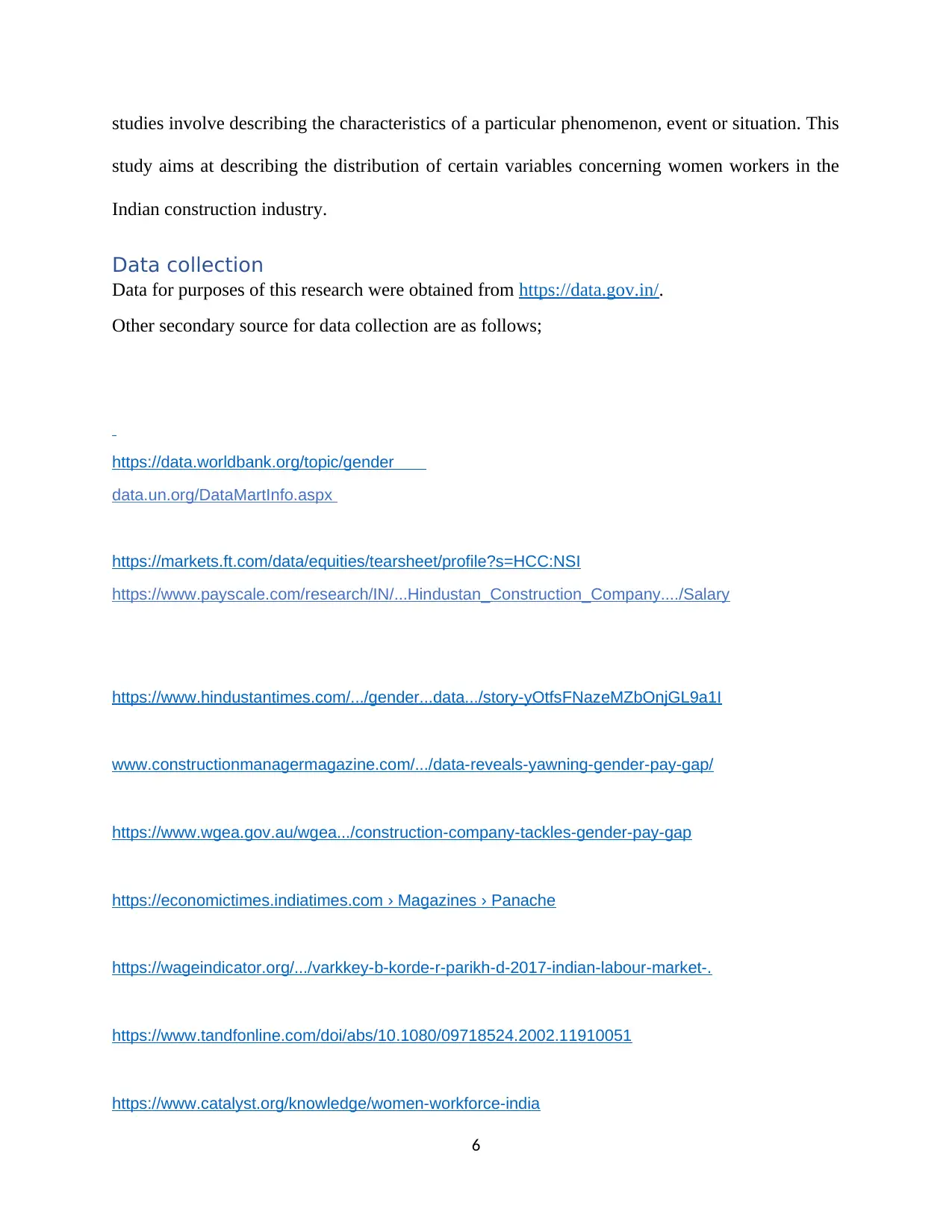
studies involve describing the characteristics of a particular phenomenon, event or situation. This
study aims at describing the distribution of certain variables concerning women workers in the
Indian construction industry.
Data collection
Data for purposes of this research were obtained from https://data.gov.in/.
Other secondary source for data collection are as follows;
https://data.worldbank.org/topic/gender
data.un.org/DataMartInfo.aspx
https://markets.ft.com/data/equities/tearsheet/profile?s=HCC:NSI
https://www.payscale.com/research/IN/...Hindustan_Construction_Company..../Salary
https://www.hindustantimes.com/.../gender...data.../story-yOtfsFNazeMZbOnjGL9a1I
www.constructionmanagermagazine.com/.../data-reveals-yawning-gender-pay-gap/
https://www.wgea.gov.au/wgea.../construction-company-tackles-gender-pay-gap
https://economictimes.indiatimes.com › Magazines › Panache
https://wageindicator.org/.../varkkey-b-korde-r-parikh-d-2017-indian-labour-market-.
https://www.tandfonline.com/doi/abs/10.1080/09718524.2002.11910051
https://www.catalyst.org/knowledge/women-workforce-india
6
study aims at describing the distribution of certain variables concerning women workers in the
Indian construction industry.
Data collection
Data for purposes of this research were obtained from https://data.gov.in/.
Other secondary source for data collection are as follows;
https://data.worldbank.org/topic/gender
data.un.org/DataMartInfo.aspx
https://markets.ft.com/data/equities/tearsheet/profile?s=HCC:NSI
https://www.payscale.com/research/IN/...Hindustan_Construction_Company..../Salary
https://www.hindustantimes.com/.../gender...data.../story-yOtfsFNazeMZbOnjGL9a1I
www.constructionmanagermagazine.com/.../data-reveals-yawning-gender-pay-gap/
https://www.wgea.gov.au/wgea.../construction-company-tackles-gender-pay-gap
https://economictimes.indiatimes.com › Magazines › Panache
https://wageindicator.org/.../varkkey-b-korde-r-parikh-d-2017-indian-labour-market-.
https://www.tandfonline.com/doi/abs/10.1080/09718524.2002.11910051
https://www.catalyst.org/knowledge/women-workforce-india
6
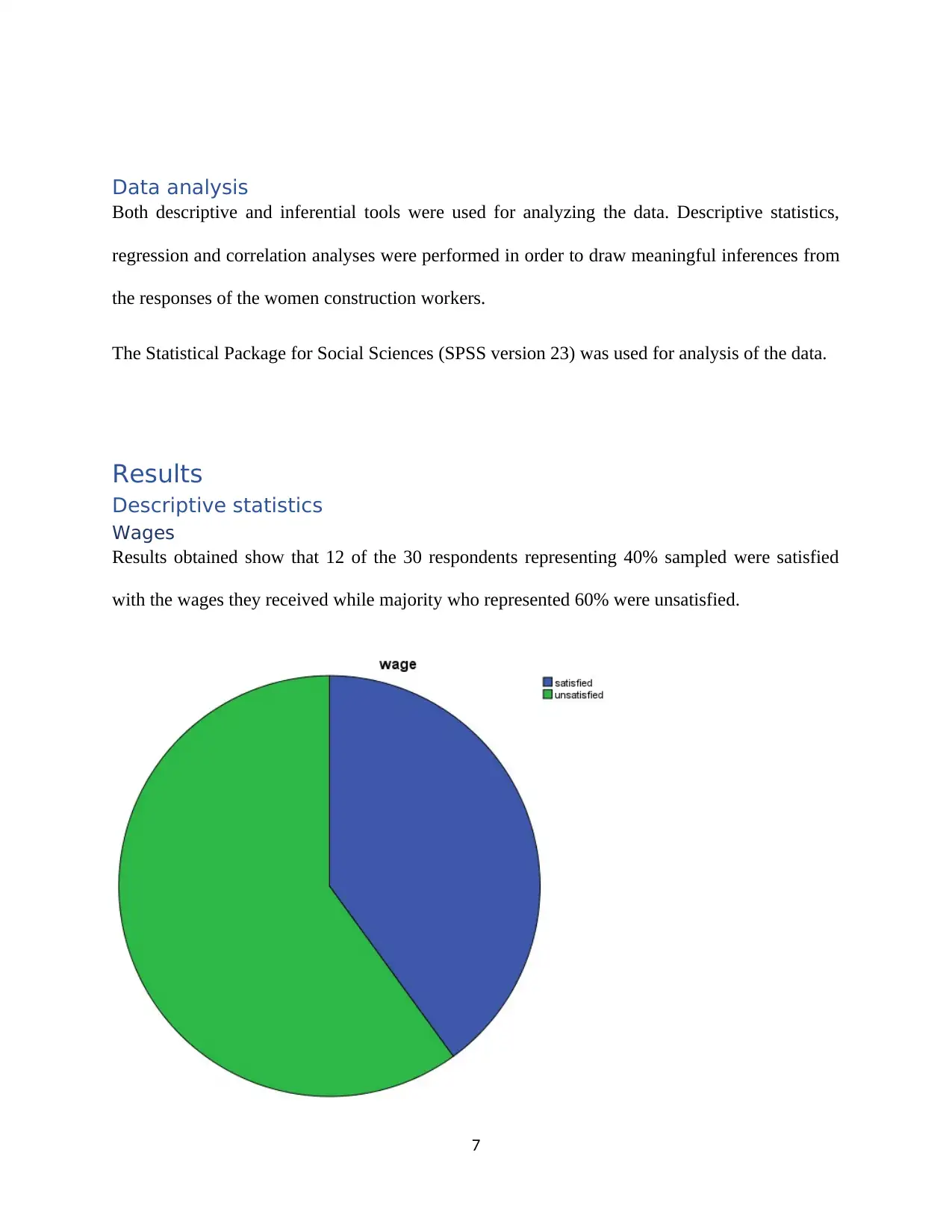
Data analysis
Both descriptive and inferential tools were used for analyzing the data. Descriptive statistics,
regression and correlation analyses were performed in order to draw meaningful inferences from
the responses of the women construction workers.
The Statistical Package for Social Sciences (SPSS version 23) was used for analysis of the data.
Results
Descriptive statistics
Wages
Results obtained show that 12 of the 30 respondents representing 40% sampled were satisfied
with the wages they received while majority who represented 60% were unsatisfied.
7
Both descriptive and inferential tools were used for analyzing the data. Descriptive statistics,
regression and correlation analyses were performed in order to draw meaningful inferences from
the responses of the women construction workers.
The Statistical Package for Social Sciences (SPSS version 23) was used for analysis of the data.
Results
Descriptive statistics
Wages
Results obtained show that 12 of the 30 respondents representing 40% sampled were satisfied
with the wages they received while majority who represented 60% were unsatisfied.
7
⊘ This is a preview!⊘
Do you want full access?
Subscribe today to unlock all pages.

Trusted by 1+ million students worldwide
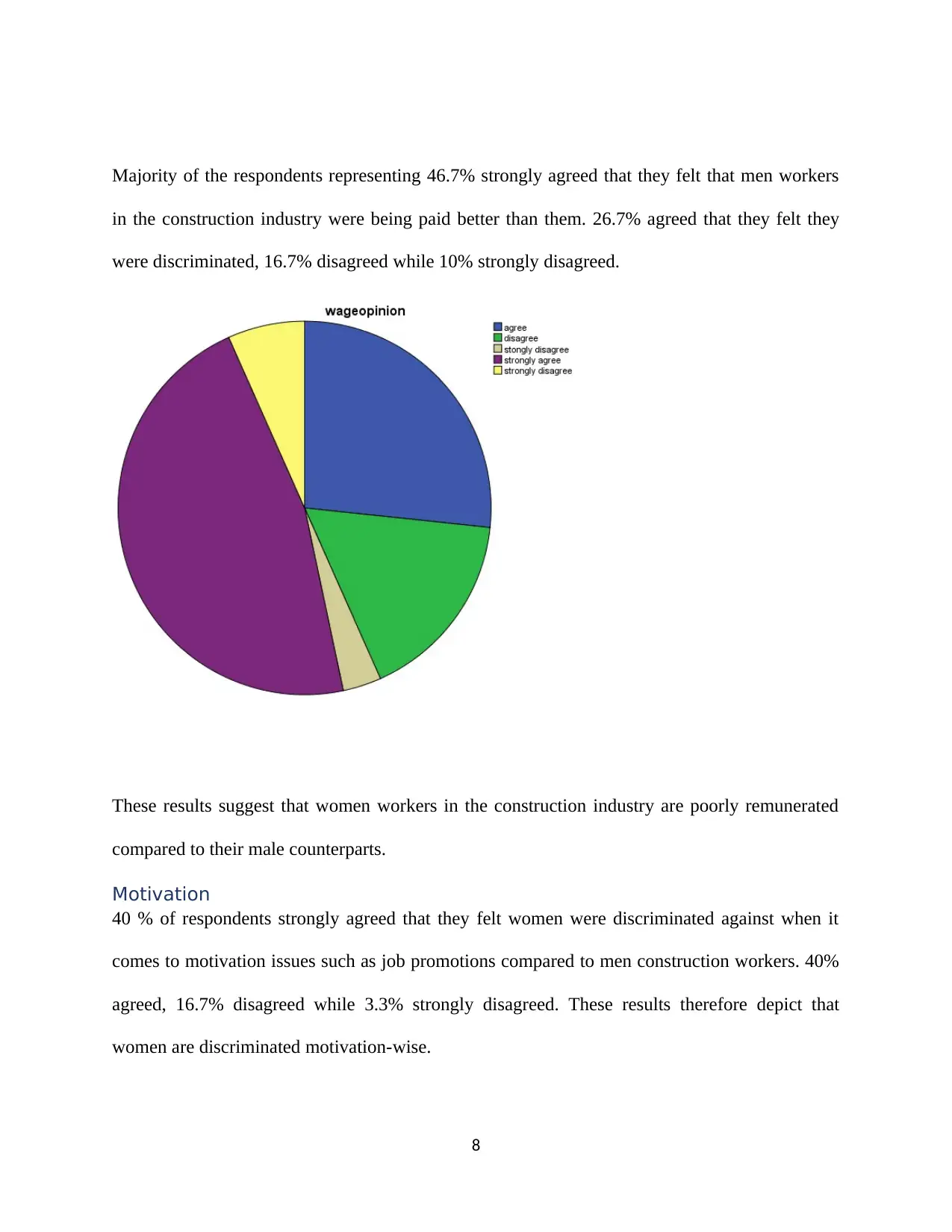
Majority of the respondents representing 46.7% strongly agreed that they felt that men workers
in the construction industry were being paid better than them. 26.7% agreed that they felt they
were discriminated, 16.7% disagreed while 10% strongly disagreed.
These results suggest that women workers in the construction industry are poorly remunerated
compared to their male counterparts.
Motivation
40 % of respondents strongly agreed that they felt women were discriminated against when it
comes to motivation issues such as job promotions compared to men construction workers. 40%
agreed, 16.7% disagreed while 3.3% strongly disagreed. These results therefore depict that
women are discriminated motivation-wise.
8
in the construction industry were being paid better than them. 26.7% agreed that they felt they
were discriminated, 16.7% disagreed while 10% strongly disagreed.
These results suggest that women workers in the construction industry are poorly remunerated
compared to their male counterparts.
Motivation
40 % of respondents strongly agreed that they felt women were discriminated against when it
comes to motivation issues such as job promotions compared to men construction workers. 40%
agreed, 16.7% disagreed while 3.3% strongly disagreed. These results therefore depict that
women are discriminated motivation-wise.
8
Paraphrase This Document
Need a fresh take? Get an instant paraphrase of this document with our AI Paraphraser
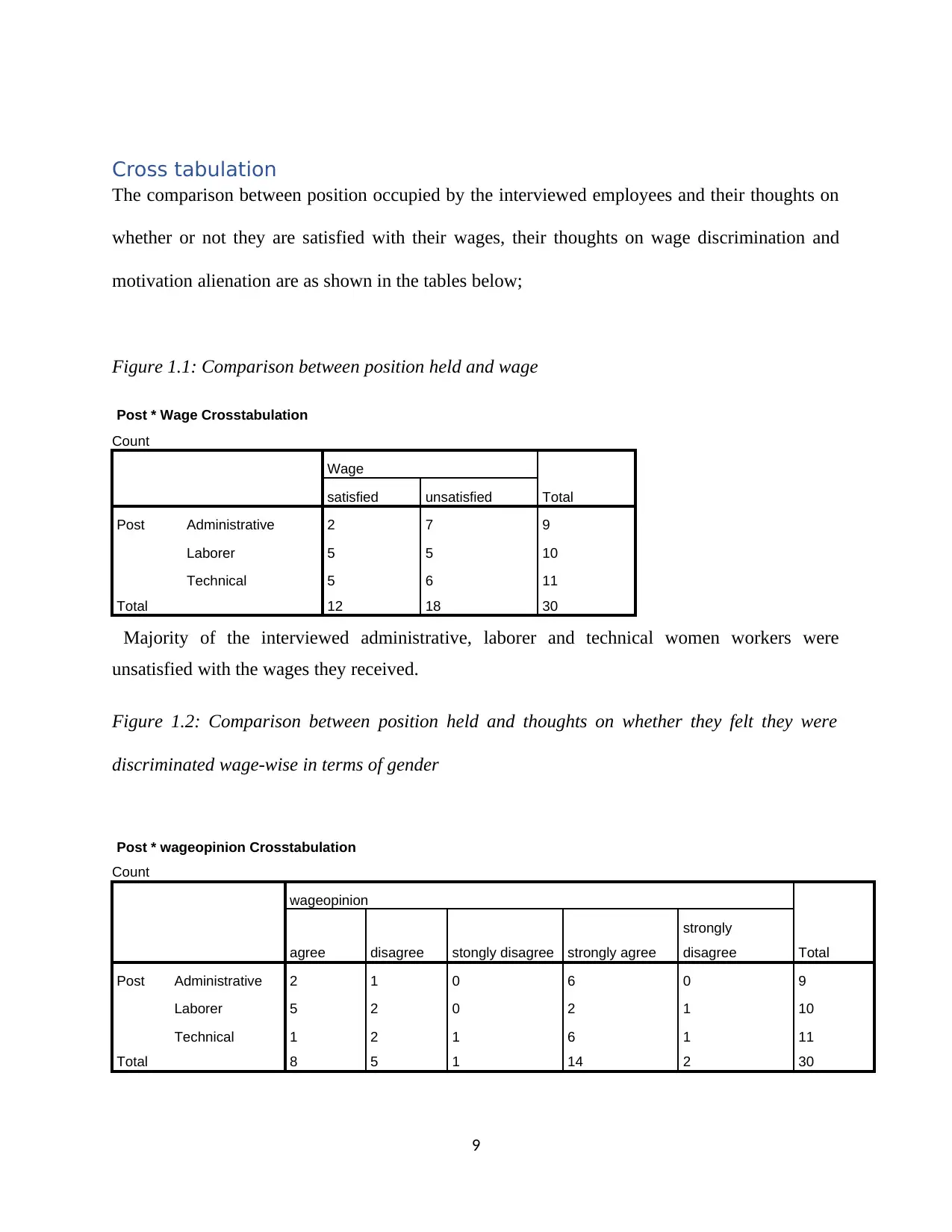
Cross tabulation
The comparison between position occupied by the interviewed employees and their thoughts on
whether or not they are satisfied with their wages, their thoughts on wage discrimination and
motivation alienation are as shown in the tables below;
Figure 1.1: Comparison between position held and wage
Post * Wage Crosstabulation
Count
Wage
Totalsatisfied unsatisfied
Post Administrative 2 7 9
Laborer 5 5 10
Technical 5 6 11
Total 12 18 30
Majority of the interviewed administrative, laborer and technical women workers were
unsatisfied with the wages they received.
Figure 1.2: Comparison between position held and thoughts on whether they felt they were
discriminated wage-wise in terms of gender
Post * wageopinion Crosstabulation
Count
wageopinion
Totalagree disagree stongly disagree strongly agree
strongly
disagree
Post Administrative 2 1 0 6 0 9
Laborer 5 2 0 2 1 10
Technical 1 2 1 6 1 11
Total 8 5 1 14 2 30
9
The comparison between position occupied by the interviewed employees and their thoughts on
whether or not they are satisfied with their wages, their thoughts on wage discrimination and
motivation alienation are as shown in the tables below;
Figure 1.1: Comparison between position held and wage
Post * Wage Crosstabulation
Count
Wage
Totalsatisfied unsatisfied
Post Administrative 2 7 9
Laborer 5 5 10
Technical 5 6 11
Total 12 18 30
Majority of the interviewed administrative, laborer and technical women workers were
unsatisfied with the wages they received.
Figure 1.2: Comparison between position held and thoughts on whether they felt they were
discriminated wage-wise in terms of gender
Post * wageopinion Crosstabulation
Count
wageopinion
Totalagree disagree stongly disagree strongly agree
strongly
disagree
Post Administrative 2 1 0 6 0 9
Laborer 5 2 0 2 1 10
Technical 1 2 1 6 1 11
Total 8 5 1 14 2 30
9
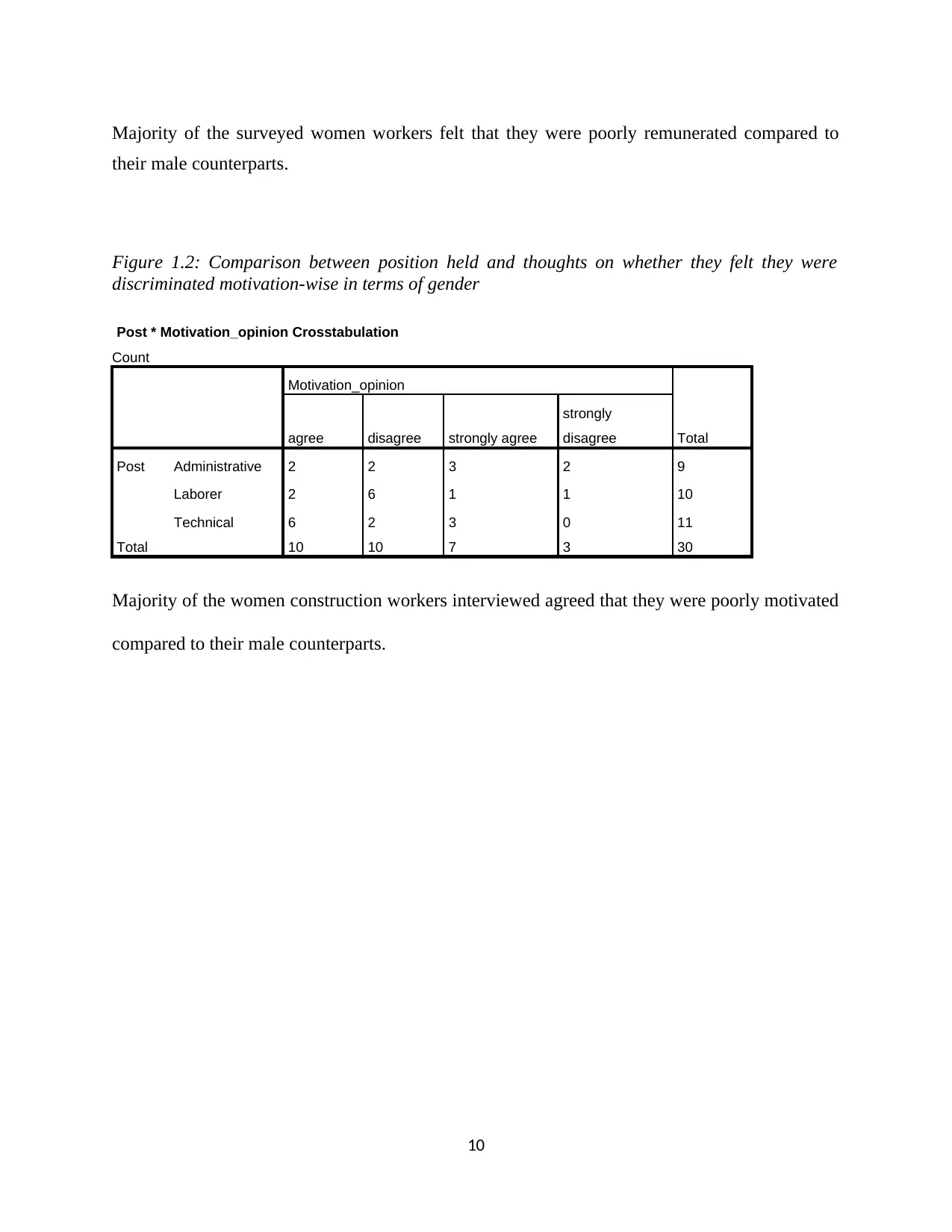
Majority of the surveyed women workers felt that they were poorly remunerated compared to
their male counterparts.
Figure 1.2: Comparison between position held and thoughts on whether they felt they were
discriminated motivation-wise in terms of gender
Post * Motivation_opinion Crosstabulation
Count
Motivation_opinion
Totalagree disagree strongly agree
strongly
disagree
Post Administrative 2 2 3 2 9
Laborer 2 6 1 1 10
Technical 6 2 3 0 11
Total 10 10 7 3 30
Majority of the women construction workers interviewed agreed that they were poorly motivated
compared to their male counterparts.
10
their male counterparts.
Figure 1.2: Comparison between position held and thoughts on whether they felt they were
discriminated motivation-wise in terms of gender
Post * Motivation_opinion Crosstabulation
Count
Motivation_opinion
Totalagree disagree strongly agree
strongly
disagree
Post Administrative 2 2 3 2 9
Laborer 2 6 1 1 10
Technical 6 2 3 0 11
Total 10 10 7 3 30
Majority of the women construction workers interviewed agreed that they were poorly motivated
compared to their male counterparts.
10
⊘ This is a preview!⊘
Do you want full access?
Subscribe today to unlock all pages.

Trusted by 1+ million students worldwide
1 out of 21
Related Documents
Your All-in-One AI-Powered Toolkit for Academic Success.
+13062052269
info@desklib.com
Available 24*7 on WhatsApp / Email
![[object Object]](/_next/static/media/star-bottom.7253800d.svg)
Unlock your academic potential
Copyright © 2020–2025 A2Z Services. All Rights Reserved. Developed and managed by ZUCOL.





